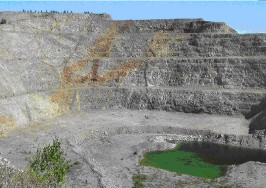
The Ermakovka fluorine-beryllium deposit, being the largest one in Russia is located in Eastern Bury-atia, 140 km east of Ulan-Ude town. The deposit localizes in the metamorphosed carbonate-terrigene sediments of the suggested Proterozoic age that compose the large (10-12 sq.km) roof pendant in the area of the dominant Pre-Cambrian (?) and Paleozoic granitoids. The deposit area is in the pre-flange part of the Kizhinga Mesozoic depression. The Late Triassic intrusions that are spread in the deposit area are rep-resented by the pre-ore dykes of the middle and acid compositions and syn-ore stock of aegerine leuco-cranites being considered as a source of the ore-forming fluids.
The fluorite-beryllium mineralization forms mostly by the layer metasomatic zones of complex inner structure that are extended enough by strike and dip. They belong to the slopes and core part of syncline and mostly occur within the batch of the carbonate rock and schist interbedding. 9 ore zones with balance reserves have been distinguished at the deposit. The average content of BeO in ores equaled 1.3% at the start of the development. In the remaining ores, the contents of BeO and fluorite average 1.19% and 24.6% respectively. The groundmass of BeO (92-93%) is concentrated in bertrandite and phenacite, the other Be minerals (melinophane, leucophane, eudidymite, bavenite, milarite and helvite) that occur spo-radically make up 7-8%.
Reyf, Chemical Geology, 210 (2004).
| 